Sunday, August 24, 2008
Beware Creeping Jenny
It all seemed so innocent at the time ... about three years ago, while picking out plants for my ornamental pots, I came across a beautiful lime green vining plant that looked different from the usual sweet potato vines, vinca and bacopa. It's common name was Creeping Jenny. Creeping Jenny, also known as moneywort, is a fast growing, prostrate plant with pairs or round, penny-sized leaves along the slender stems that snake out from the center of the plant. Plants grow about 2 inches tall but will spread as wide as space permits. And I do mean as wide as space permits.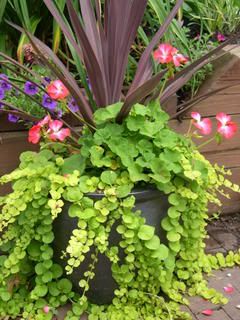 I swear I only planted Jenny in my pots, but somehow, by the end of that first season, "she" managed to spread into the garden path, along the edge of the pond, and over a few of my flower beds that weren't even near the pots. Although it's a nice looking plant, I had no idea how absolutely invasive it is.
I swear I only planted Jenny in my pots, but somehow, by the end of that first season, "she" managed to spread into the garden path, along the edge of the pond, and over a few of my flower beds that weren't even near the pots. Although it's a nice looking plant, I had no idea how absolutely invasive it is.  The most common form of creeping Jenny in local nurseries is the golden-leafed cultivar ‘Aurea’ which has bright, chartreuse leaves in the spring that take on a somewhat more subdued tone as they age.A quick check of the Internet finds lots of people having trouble with this plant. One claims to have sprayed it with Round-Up, to no avail. Apparently it is very difficult to control because of its extensive root system.
The most common form of creeping Jenny in local nurseries is the golden-leafed cultivar ‘Aurea’ which has bright, chartreuse leaves in the spring that take on a somewhat more subdued tone as they age.A quick check of the Internet finds lots of people having trouble with this plant. One claims to have sprayed it with Round-Up, to no avail. Apparently it is very difficult to control because of its extensive root system. 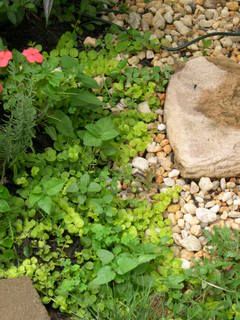 However, there were some suggestions for controlling it. In turf situations, where cultivation is not practical, a postemergent herbicide is recommended. Small infestations in nonturf areas sometimes may be controlled by covering the area with mulch and not allowing any green plant material to emerge. Multiple applications may be required for complete eradication.So try Creeping Jenny at your own risk, or let me know if you've already encountered this invasive groundcover and had any luck getting rid of it.
However, there were some suggestions for controlling it. In turf situations, where cultivation is not practical, a postemergent herbicide is recommended. Small infestations in nonturf areas sometimes may be controlled by covering the area with mulch and not allowing any green plant material to emerge. Multiple applications may be required for complete eradication.So try Creeping Jenny at your own risk, or let me know if you've already encountered this invasive groundcover and had any luck getting rid of it.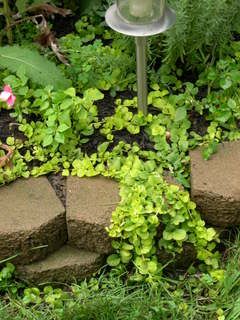 FYI -- I'll be on vacation and away from a computer for the next two weeks (whatever am I going to do without the Internet??) Anyway, I won't be posting any new entries until after Sept. 8. Then it'll be on to fall planting and prep. Till then ...
FYI -- I'll be on vacation and away from a computer for the next two weeks (whatever am I going to do without the Internet??) Anyway, I won't be posting any new entries until after Sept. 8. Then it'll be on to fall planting and prep. Till then ...Labels: creeping jenny, invasive plants, moneywort
Friday, August 22, 2008
Perennial Hibiscus
This time of year, there's just nothing more impressive in my garden, including the stargazer lilly, than my perennial hisbiscus plants. The salad plate-sized flowers are too stupendous to describe, so I'm providing a few photos that I hope do them justice. 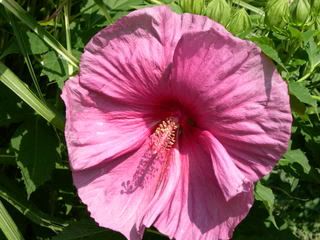 I currently have two hibiscus plants, one that is a survivor of a 4-pack of plants that I purchased off QVC from Cottage Farms (remember yesterday I was telling you how I learned my lesson about buying plants off TV -- well I didn't admit defeat right away, it took a couple times). The other one was bought locally from Glick's Greenhouse. Both plants are about four years old.I couldn't wait to see them bloom the first year I planted them. The blooms don't come until about mid-August, and one morning I looked out the window to see the most gorgeous plate-sized flower beaming back at me! Of course, I took photos and invited the family to see it. Unfortunately, to my surprise, the bloom only lasted one day. The very next morning I looked out and thought "where'd it go?" It was already drooped and parts of it were on the ground. That was the only bloom I got that first year. This year, the blooms are coming in abundance and both plants are entering their third week of constant blooming!
I currently have two hibiscus plants, one that is a survivor of a 4-pack of plants that I purchased off QVC from Cottage Farms (remember yesterday I was telling you how I learned my lesson about buying plants off TV -- well I didn't admit defeat right away, it took a couple times). The other one was bought locally from Glick's Greenhouse. Both plants are about four years old.I couldn't wait to see them bloom the first year I planted them. The blooms don't come until about mid-August, and one morning I looked out the window to see the most gorgeous plate-sized flower beaming back at me! Of course, I took photos and invited the family to see it. Unfortunately, to my surprise, the bloom only lasted one day. The very next morning I looked out and thought "where'd it go?" It was already drooped and parts of it were on the ground. That was the only bloom I got that first year. This year, the blooms are coming in abundance and both plants are entering their third week of constant blooming!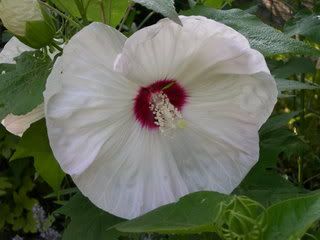 If you're interested, here's a few facts. Perennial hibiscus plants, those that come back for several years without replanting, are rapidly gaining favor with plant lovers across the nation. If you wish to enjoy a plant that is easy to care for, try the perennial hibiscus. Our zone (6) is perfect for this plant.The perennial hibiscus should not be confused with the tropical hibiscus, which would not survive our winters. As the name implies, perennial hibiscus are truly perennial and, once established, will provide years and years of brilliant landscape color. There are many varieties of perennial hibiscus to choose from. Plant heights range from 3 feet to 8 feet tall. They can be used in the garden as focal point or arranged in a manner to provide an informal hedge. Some perennial hibiscus plants are compact and rather formal looking compared with the more loosely arranged habit of taller hibiscus.
If you're interested, here's a few facts. Perennial hibiscus plants, those that come back for several years without replanting, are rapidly gaining favor with plant lovers across the nation. If you wish to enjoy a plant that is easy to care for, try the perennial hibiscus. Our zone (6) is perfect for this plant.The perennial hibiscus should not be confused with the tropical hibiscus, which would not survive our winters. As the name implies, perennial hibiscus are truly perennial and, once established, will provide years and years of brilliant landscape color. There are many varieties of perennial hibiscus to choose from. Plant heights range from 3 feet to 8 feet tall. They can be used in the garden as focal point or arranged in a manner to provide an informal hedge. Some perennial hibiscus plants are compact and rather formal looking compared with the more loosely arranged habit of taller hibiscus.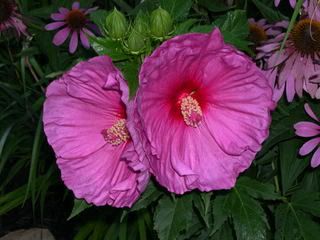 So don't be afraid to try this easy-going, versatile plant. All your neighbors will be impressed and think you're a master gardener!Up next -- beware Creeping Jenny!
So don't be afraid to try this easy-going, versatile plant. All your neighbors will be impressed and think you're a master gardener!Up next -- beware Creeping Jenny!Labels: Cottage Farms, Glick's Greenhouses, perennial hibiscus, QVC, stargazer lilly
Thursday, August 21, 2008
Stargazing ...
About four years ago, I got sucked into a presentation by Cottage Farms on QVC. I'm sure you've already seen it at least once. Those smart marketers in West Chester usually bring in Cottage Farms some time in late February/early March, when all us gardeners are stuck in the house dreaming of the upcoming spring blooms. And they always have a beautiful already-blooming specimen of what they're selling. Whether it be roses, strawberries, hydrangeas, or various collections of bulbs. The presentations are absolutely irresistable to the average gardener. All shipments come with a year-long guarantee, however, if a plant is damaged in shipment, you might not get the same plant for a replacement (but that's another story).  Anyway, it was during one of these presentations, that I couldn't help myself and decided to try the ever-blooming lilly package. I think it consisted of over 40 bulbs in all different colors and varieties. Well, long story-short, I planted each bulb according to the packaged instructions and right now (four years later) I have about seven active lillies that have actually flourished and spread in my gardens. Remember, that's 7 out of 40! And, I can't be sure, but I believe that with tax and shipping, it cost around $50 for the collection!I've since learned my lesson regarding those spectacular TV presentations ... but the lillies that have lasted are absolutely gorgeous. And no one more than the Stargazer Lilly. It's one of those pleasant surprises that blooms in August and it's spectacular!
Anyway, it was during one of these presentations, that I couldn't help myself and decided to try the ever-blooming lilly package. I think it consisted of over 40 bulbs in all different colors and varieties. Well, long story-short, I planted each bulb according to the packaged instructions and right now (four years later) I have about seven active lillies that have actually flourished and spread in my gardens. Remember, that's 7 out of 40! And, I can't be sure, but I believe that with tax and shipping, it cost around $50 for the collection!I've since learned my lesson regarding those spectacular TV presentations ... but the lillies that have lasted are absolutely gorgeous. And no one more than the Stargazer Lilly. It's one of those pleasant surprises that blooms in August and it's spectacular! Known for its striking blooms and heavenly scent, the stargazer is a fantastic choice for a number of occasions. It's delicate, bold, and fragrant all at once, and is fabulous in floral arrangements (although I like mine too much to cut them). Developed in the latter part of the 20th century, the stargazer lily is a recent addition to the lily family, but this unique and rather exotic hybrid has rapidly risen in popularity to become one of the most adored and sought-after of all lily varieties.Of the many different lilies that are available today, the stargazer lily is one of the true stand-outs. Its spectacular blooms, which can range in color from pure white to the more familiar shades of deep pink, can make a definite impression. Its dazzling appearance and seductive scent has resulted in a flower that can really make an entrance.
Known for its striking blooms and heavenly scent, the stargazer is a fantastic choice for a number of occasions. It's delicate, bold, and fragrant all at once, and is fabulous in floral arrangements (although I like mine too much to cut them). Developed in the latter part of the 20th century, the stargazer lily is a recent addition to the lily family, but this unique and rather exotic hybrid has rapidly risen in popularity to become one of the most adored and sought-after of all lily varieties.Of the many different lilies that are available today, the stargazer lily is one of the true stand-outs. Its spectacular blooms, which can range in color from pure white to the more familiar shades of deep pink, can make a definite impression. Its dazzling appearance and seductive scent has resulted in a flower that can really make an entrance.  Stargazers are floral celebrities – bold, beautiful and dramatic – and they're sure to make that statement for you, whatever the occasion may be.I highly recommend this spectacular flower, but I don't recommend buying it of TV. There are plenty of catalogs out there, as well as local nurseries where you can find this one of a kind bulb!
Stargazers are floral celebrities – bold, beautiful and dramatic – and they're sure to make that statement for you, whatever the occasion may be.I highly recommend this spectacular flower, but I don't recommend buying it of TV. There are plenty of catalogs out there, as well as local nurseries where you can find this one of a kind bulb!Labels: Cottage Farms, QVC, stargazer lillies
Monday, August 18, 2008
Late Summer Blahs
It happens this time every year ... the excitement has worn off, just about everything's bloomed and I can't even bring myself to keep up with the watering ... the Late Summer Blahs!
You fellow gardeners must know what I mean. Every spring, you can't wait to see the perennials breaking thru the surface, going to the nursery to pick out this season's crop of annuals, waiting for those first tomatoes, why even watering is an absolute pleasure in the beginning ...
I love to walk along my garden path each morning, peruse it at lunchtime and then go over it once more before twilight. But lately, I can't be bothered to do much else than make sure the waterfall's running properly, the fish have been fed and the glut of new tomatoes have been harvested. Remember just a couple of weeks ago I was complaining about the lack of red tomatoes ... I knew what was coming. Now I'm up to my ears in tomatoes, peppers and cucumbers.
And yes, although I couldn't wait for that first fresh taste ... now I'm trying to unload them on anybody I can. But it's hard because everyone's veggies are coming at the same time ... I couldn't even be bothered this weekend to chop up and freeze my peppers. I'll get to it ... sometime.
It doesn't help that my petunias and impatiens look beaten. Yes, after blogging about petunias needing lots of fertilizer, I bought Miracle Grow extra blooming formula and applied it immediately. Then I went on vacation, hoping that I would come back to refreshed, stellar blooming annuals. Not the case. I cut them back, but they still managed to get stringy. Yes, they're blooming, but not like they were in mid-July.
Same with those annual geraniums that I proudly planted in May. They were supposed to bloom all season long. Didn't happen. They're healthy for the most part (I lost a few). They've grown bigger than I thought, but the whole point was to have constant blooms. I'd have to give them a "thumbs down" at this point.
And although I was initially excited by all the salvias coming up thru the garden path on they're own, now they just look cluttered and it's getting difficult to walk thru. I have some major garden cleaning to do, but I'm just not up to it yet. I have another vacation coming up (remember I said I'd warn you), so it'll just have to wait till I get back.
Oh well, in just a few short months, I'll be missing it all again, and waiting for another spring. And soon the Blahs will pass and I'll be getting excited about fall planting ... it's just a few weeks away!

I haven't forgotten ... I'll get to the Stargazer Lillies and Hibiscus this week.Labels: cucumbers, impatiens, Miracle Grow, peppers, petunias, tomatoes
Friday, August 15, 2008
Before and After
Last week while on vacation, I got completely wrapped up in the "Twilight" series of books by Stephenie Meyer ... anyone who has read these, I'm sure, can understand why. I poured thru the 600+ pages of each of the first three books, and I'm desperate this week, concentrating all my spare time on getting thru the fourth and final book. So I haven't had my mind on or spent much time gardening ...Then I wake up this morning to find that the sixth Harry Potter movie, "Half Blood Prince," has been pushed back from Nov. 21, 2008, to a release date of July 17, 2009 -- Arrgghh!!! Not because of production problems, but to take advantage of an "open" weekend during next summer's hot movie season -- don't these studio execs realize what they're doing to us fans? Oh well, at least I can still look forward to the release of the first "Twilight" movie in December ... While I continue to grumble to myself this morning, I thought you might enjoy these "before and after" photos of my garden. The "befores" were taken back in early April of this year and the "afters" within the last two weeks. Enjoy!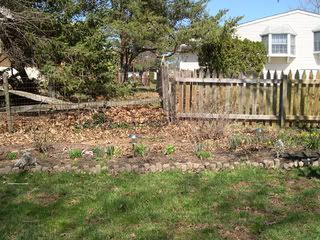

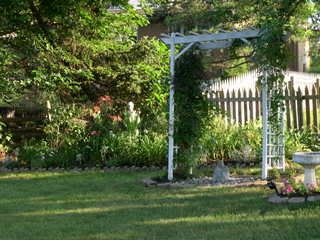


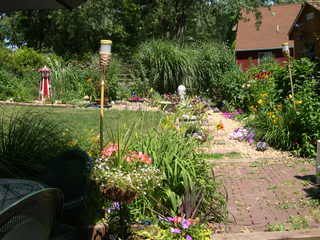

 I hope to spend the weekend sitting in my backyard oasis, finishing the saga of Edward and Bella. Till next week ...
I hope to spend the weekend sitting in my backyard oasis, finishing the saga of Edward and Bella. Till next week ...Labels: gardening photos, half blood prince, harry potter, stephenie meyer, Twilight books
Wednesday, August 13, 2008
Balloon Flowers
Hi, sorry to have left everyone hanging for so long, I was away on vacation last week, and as I've stated before, it takes me a couple of days to clear the mess on my desk here at work when I get back. I promise next time I'll give you an advanced warning. 
Last night a friend and coworker of mine brought over some flowers she'd divided at her house. I was thrilled that she brought me some more of her vibrant balloon flowers!
What are balloon flowers? Well, I'm glad you asked...
Also known as the Chinese Bellflower, this heavy bloomer gets its name from the way each flower bud swells before its starry petals unfold. Balloon flowers are one of the easiest perennials you'll ever grow, and they bloom in profusion in mid to late summer, when many other perennials are beginning to fade. 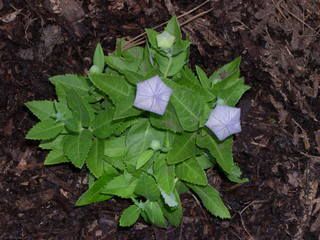
The upward-facing flowers bloom throughout the summer and into early fall in shades of blue, pink and white. The plants form a low, neat mound and bear 2- to 3-inch cuplike blossoms accented with delicate purple veins and yellow stamens. Balloon flowers are a cottage garden standard, and they are excellent for cutting. To make the flowers last in the vase, sear the stems with a match or candle flame immediately after cutting.
Balloon flowers grow in Zones 3-8. They thrive in full sun or light shade in well-drained garden soil. They appreciate a little afternoon shade in our zone (6). You won't find a more carefree perennial! Just work a little slow release fertilizer into the soil in spring, and pick off the flowers as they fade to encourage more blooms. Moderate drought conditions aren't a problem, but it helps to water the plants deeply when the soil dries out too much or if drought conditions persist. Balloon flowers are seldom bothered by insects, and they are very cold-hardy. I like this perennial so much, that we just added some to our landscape at our vacation home. These picture were taken there, just after they had been planted.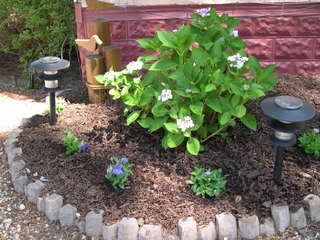
So go get some balloon flowers of your own, you won't be disappointed!
Coming up -- the showstopping Stargazer Lilly and my salad plate-sized Hibiscus flowers!
Friday, August 1, 2008
Mystery Plant
Every year, towards the end of summer, I can't help but go to my favorite greenhouse just to see what bargains might be left for the taking. You never know when you might find something great that's been overlooked.
About five years ago, while perusing leftover annuals and perennials at Glick's Greenhouses in Oley, an odd-looking plant caught my eye. It had two stems about 5-ft. tall with large blooms resembling sunflowers. It was in the area of the perennials, and I thought how great would it be to have a perennial "sunflower." There was no tag, so I had no idea what this "mystery" plant actually was, other than perennial.
It cost $1.95, so I figured what the heck ... I took it home and found a spot near the corner of the garden pathway, between a butterfly bush and clematis. I couldn't wait till the next summer to see what it would do.
Well, it certainly didn't disappoint. The plant came up abundant the next year, much more dense than the two stems I had purchased it as. It grew at least 4-ft. tall and had fabulous sunflower-like yellow blooms from July-September. We absolutely loved it and referred to it as our "sunflower bush."
It continued to stay hardy and spread. I had to start digging it up each year, because it was spreading too much. I've given it to my mother, friends and coworkers and they've all had success. I've planted it all along our fence and it provides a beautiful screen.
I recently found it in a nursery while on vacation and, after learning its proper name (helianthus x multiflorus), looked it up on the Internet. Here's what I found.
It's common name is Capenoch Star, and it is actually considered a Perennial Sunflower. Who knew? It's clean, deep green leaves give way to large, single, bright yellow flowers that are reminiscent of annual sunflowers with their wide centers. Refreshing and attractive .. especially to butterflies and bees. It prefers moist soils in full sun, but is tolerant of drought and light shade. Fertilizer is recommended, but believe me, I've never had to do anything to propagate this plant. It may be divided or can be rooted thru cuttings. 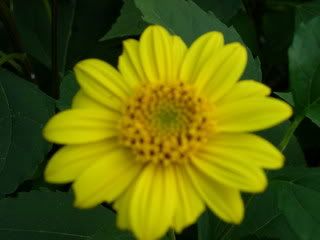
The site warns that Helianthus can be quite invasive, which I've found to be true. And because of its height, it's best utilized in the back of a border garden to accent lower growing perennials.
So don't ever be afraid of buying that Mystery Plant. Sometimes you get a better bargain than you ever thought you would!Labels: Capenoch Star, Glick's Greenhouses, helianthus x multiflorus, mystery plant, perennials, sunflowers




 RSS
RSS






















